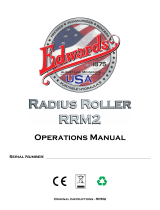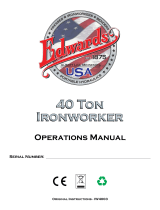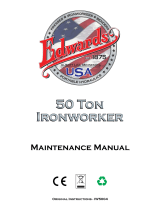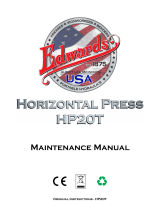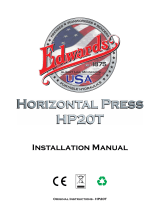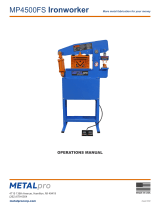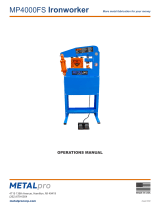Page is loading ...

Safety Instructions Manual
Original Instructions - IW6502

1
Operator and Supervisor Information
This is one of four manuals supplied with your machine.
• Installation Manual
• Safety Instructions Manual
• Operations Manual
• Maintenance Manual
READ ALL MANUALS BEFORE OPERATING MACHINERY. Operating
machinery before reading and understanding the contents of all four
manuals greatly increases the risk of injury.
Each of the four machine manuals describe ‘best practices’ in handling,
installing, operating and maintaining your machine. The contents of
each manual is subject to change without notice due to improvements
in the machinery or changes in National or International standards.
All rights reserved. Reproduction of this manual in any form, in whole or
in part, is not permitted without the written consent of Edwards Manu-
facturing Company.
Keep all manuals close to the machine to allow for easy reference when
necessary.
Provide operators with sufcient training and education in the basic
functions of the machine prior to machine operation.
Do not allow for operation of the machine by unqualied personnel. Ed-
wards Manufacturing Company is not liable for accidents arising from
unskilled, untrained operation.
Do not modify or change the machine without written authorization from
Edwards Manufacturing Company. Unauthorized modication to a ma-
chine may result in serious operator injury, machine damage and will
void your machine warranty.
Never leave a powered machine unattended. Turn machinery OFF be-
fore walking away.
This machine is manufactured for use by able bodied and able minded
operators only. Never operate machinery when tired or under the inu-
ence of drugs or alcohol.
Do not resell, relocate or export to a destination other than to the original
point of sale. Edwards has designed this machine to meet the stan-
dards of the original receiving country and is not liable for meeting any
governing body or performance standards beyond those of the original
receiving country.
Signal Word Definition
Indicates a hazardous situation that, if not avoided,
will result in death or serious injury.
Indicates a hazardous situation that, if not avoided,
could result in death or serious injury.
Indicates a hazardous situation that, if not avoided,
could result in mild or moderate injury.
Indicates information considered important, but not
hazard related.
Signal Word Panel on Machine
Critical machine safety information is identied on signal word labels.
Labels are attached adjacent to the potentially hazardous locations of the
machine. Reference the Safety Instruction Manual for additional informa-
tion regarding the potentially hazardous condition identied on the label.
Review ALL labels on the machinery, reference the operational pre-
cautions and safe operations sections within this manual before any
operation activity is initiated.
Failure to read and understand the signal word labels afxed to the
machinery may result in operator death or injury.
1 General
Operator and Supervisor Information
Signal Word Denition
Signal Word Panel
2 Signal Word Panel - Machine Front
3 Signal Word Panel - Machine Back
4 Signal Word Panel - Machine Right
5 Signal Word Panel - Machine Left
6 Signal Words
Danger Panel
Warning Panel
Notice Panel
Additional Graphic Information
Safety Manual Table of Contents

2 3
Signal Word Panel • Machine Front Signal Word Panel • Machine Back
ACCESSORY AUTO
CUT
IRON
WORKER
Read, understand, and follow
all labels shown on the machine
and described in the:
• Safety Instructions Manual
• Installation Manual
• Operations Manual
• Maintenance Manual
Keep all manuals close for easy
reference.
Trained and authorized
personnel are to install, operate
and service this machinery. Do
not allow for operation of the
machine by unqualified
personnel.
Personal protective equipment
must be worn at all times
during machinery operation.
DO NOT REMOVE, DESTROY OR
COVER THIS LABEL.
HYDRAULIC / ACCESSORY CONTROLS
POWERED BY IRONWORKER.
OPERATIONS CONTROL
KEEP OUT
Lockout
power before
servicing.
Hazardous
voltage inside.

4 5
Signal Word Panel • Machine Right Signal Word Panel • Machine Left
PUSH BUTTON LIMIT SWITCH
FLUID
INJECTION
HAZARD
Fluid under
pressure.
P.P.E.
Required
Hydraulic
accessory
controls
powered by
ironworker.
AUTO CUT AUX LIGHT
NOTICE
When adjusting
Electric Stroke
Control confirm red
light is illuminated
at top of stroke.
Keep
guards
in place.
Moving
parts can
cut and
crush.
SHEAR/
CRUSH
HAZARD
Keep
guards
in place.
Moving
parts can
cut and
crush.
SHEAR/
CRUSH
HAZARD
Hydraulic Accesory Pack Optional

6 7
Danger Panel Warning Panel
Electrical Hazard
This is the electrical hazard symbol. It
indicates there are dangerous high volt-
ages present inside the enclosure of this
product. ONLY qualied, authorized, main-
tenance, service or Certied Electricians
should gain access to electrical panel. Do
not operate this equipment from any power
source that does not match the voltage
rating stamped on the equipment. Refer to
the Manufacturer’s Identication Label for
operational requirements.
Lockout Power
Danger circuits are live. Lockout/Tagout the
upstream power source. Lockout/Tagout
machinery according to Employer proce-
dures.
Voltage (Varies by consumer requirement)
Indication of operating power requirements.
This product should be operated only from
the type of source indicated on the manu-
facturer’s identication label Installation
should be in compliance with applicable
sections of the National Electric Code.
Consult your local building code before
installing.
Phase (Varies by consumer requirement)
Indication of electrical phase requirements.
This product should be operated only from
the type of source indicated on the manu-
facturer’s identication label Installation
should be in compliance with applicable
sections of the National Electric Code.
Consult your local building code before
installing.
Horsepower (Varies by model)
Indication of horsepower requirements. This
product should be operated only from the
type of source indicated on the manufactur-
er’s identication label Installation should
be in compliance with applicable sections
of the National Electric Code. Consult your
local building code before installing.
Hertz (Varies by consumer requirement)
Indication of electrical cycles per second.
This product should be operated only from
the type of source indicated on the manu-
facturer’s identication label Installation
should be in compliance with applicable
sections of the National Electric Code.
Consult your local building code before
installing.
Shear/Crush Hazard
Moving parts can cut and crush. Keep
hands clear while operating. Lockout
power before servicing. Immediately
replace guards after adjustment, repair or
service.
Wear Personal Protective
Equipment
To avoid physical hazard, always wear per-
sonal protective equipment. Wear protec-
tive eyewear, clothing, gloves, footwear,
head-gear and hearing protection while
operating or servicing this machinery.
Fluid Injection Hazard
Hydraulic hoses and cylinders are under
pressure. Pressurized uid can pierce skin
and cause severe injury. To avoid physical
hazard, always wear personal protective
equipment. Keep hands clear while oper-
ating. Lockout power before servicing.
Immediately replace guards after adjust-
ment, repair or service.
Do Not Operate With Guard
Removed
Physical barriers and guards have been
designed and installed to protect the oper-
ator from moving parts that can pinch, cut
and crush. Keep hands clear while oper-
ating. Lockout power before servicing.
Immediately replace guards after adjust-
ment, repair or service to moving parts.
Notice Panel
Ironworker Operation
This manual outlines the basic functions
associated with typical Ironworker opera-
tions and is neither intended to create a
comprehensive list of, nor describe every
operation possible with an Ironworker
tool. Ironworker machines are designed to
punch, shear and notch mild steel (A36)
plate, barstock and angle. A wide range of
accessories are available to fabricate rod,
square stock, sheet metal and pipe. DO NOT
USE THIS EQUIPMENT FOR ANY PURPOSE
NOT DESCRIBED IN THE MANUALS.
Ironworker machines are dangerous
and require extreme care and caution
in the safe installation, operation and
maintenance of the machinery. Edwards
Manufacturing Company strongly sug-
gests reading and understanding all
manuals associated with the machinery
as well as obtaining certied, techni-
cal, industrial machinery operations
and maintenance training to reduce the
risk of injury. Regardless of the contents
of the machinery manuals Edwards
Manufacturing Company will not be held
liable for accidents caused by lack of
training.
Wear Personal Protective
Equipment
To avoid physical hazard, always wear per-
sonal protective equipment. Wear protec-
tive eyewear, clothing, gloves, footwear,
head-gear and hearing protection while
operating or servicing this machinery.
Forklift Location
This machine is equiped with rated fork-
lift movement points. Do not attempt to
lift the machinery by any other means.
Inappropriate movement of the machin-
ery may result in serious operator injury,
machine damage and will void machine
warranty. Consult the installation manual
for equipment weight ratings. Provide
rated forklift and certied forklift operator
to move machinery to appropriate location.
Refer to Manuals:
Safety, Installation, Operations
and Maintenance
Manuals contain critical instructions
regarding proper procedures for your
machinery. Understand the contents of all
manuals thoroughly. Failure to follow proper
procedures may result in serious operator
injury, machine damage and will void your
machine warranty. Keep manuals close to
the machine for easy reference.
Heat Hazard
To avoid physical burn hazard, always
wear personal protective equipment. Wear
protective clothing and gloves while work-
ing adjacent to or on the affected surface.
Safety Ground
Safety earth ground location.
Do Not Use Non-Approved
Lubricants
This machine requires lubrication of
moving mechanical parts (grease) and the
maintenance of hydraulic uids. Consult
maintenance manual for specic lubrication
requirements and application or mainte-
nance schedules.
PE
‘Protective earth’, electrical grounding
location.
Additional Graphic
Information
Electric Motor Rotation (Above)
Identication of proper electrical motor
rotation.
Conformité Européenne
Conformity with all legal requirements per-
taining to the equipment with the European
Economic Area.
Hydraulics
Hydraulic uids must be recycled as
required by local environmental law. Do not
dispose of by adding to the municipal waste
stream.

8
Additional Graphic
Information
Electronics
Electronic equipment must be recycled as
required by local environmental law. Do not
dispose of by adding to the municipal waste
stream.
Metal
Metal components must be recycled as
required by local environmental law. Do not
dispose of by adding to the municipal waste
stream.

P.O. Box 166, Albert Lea, MN 56007 800-373-8206 www.edwardsironworkers.com
S
/

